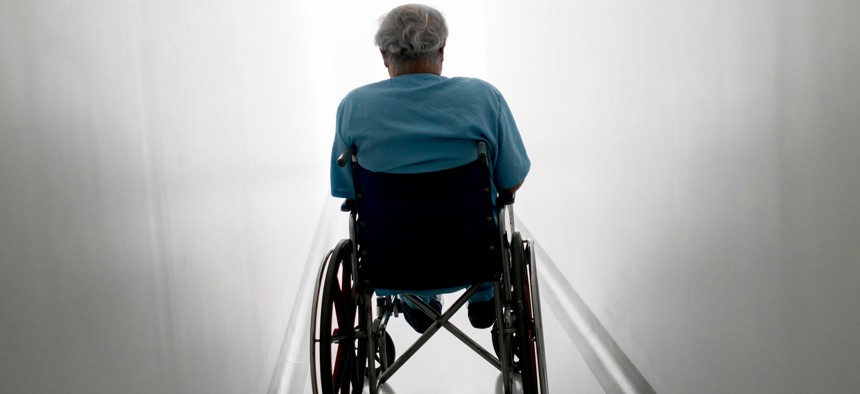Graying prisons face accelerating health care needs

GettyImages/andresr
Rapidly growing numbers of older inmates with diabetes, dementia and liver disease are forcing states to reevaluate early release policies and the social safety nets that might prevent incarceration.
Prisoners are getting older. The population of inmates aged 50 and older is rapidly increasing, putting a strain on state correctional facilities that are now struggling to meet inmates’ increasing health care needs.
In Florida, which has the third highest percentage of elderly prisoners, the proportion who are 50 and older has steadily grown in the past four decades, going from 4.5% of the population in 1980 to 16% in 2010 to 26.2% in 2018 and almost 28% in 2022. Similarly, Virginia saw the population of prisoners age 55 and older double to 14% from 7% in the past decade, according to a recent Prison Policy Institute report. As of June 30, almost 7,000 inmates in Virginia state
prisons were at least 50 years old, comprising 26.5% of the total population, an email from a Virginia Department of Corrections spokesman states.
The fact is that “older adults represent a growing portion of people who are arrested and incarcerated each year,” according to the Prison Policy Initiative’s research, and they cost twice as much to incarcerate. One reason may be they require more health care.
A 2018 report found that the cost of providing health care to Virginia prison inmates increased 40% in a decade. On per capita basis, medical expenditures have increased from about $7,200 to $10,800 between fiscal 2018 and 2022, officials at the Virginia Department of Corrections said. “While it is generally difficult to predict medical costs, the historical increases in these costs have been attributed to inflation, the rising costs of medical services (whether provided by DOC staff or contracted services), and the impact of providing medical care to an increasingly older inmate population with chronic illnesses and a population entering the system with more acute medical needs,” the DOC spokesman said.
The growing number of older prisoners and their increasing health care needs are putting states in a bind. Some are trying to reduce the number of older adults being incarcerated, others are reallocating resources to care for inmates with health problems and some are advocating early release programs. But despite states’ efforts, the number of incarcerated individuals age 50 and over is increasing.
There’s no standard definition of “elderly” in the corrections system. The Federal Bureau of Prisons says it’s 50, but states use 50, 55, 60 or 65. Prisons’ definition of old age “is lower than what you would consider to be old age in the general population,” said Samuel Scaggs, a research criminologist at RTI International, a nonprofit research organization. “This definition of old age in prisons is based on evidence that the health-related needs of prison residents are advanced by around 10 years, relative to people in the general population,” he said. “For example, a 50-year-old in prison would have the health care needs typically associated with a 60-year-old in the general community.”
That accelerated aging may result from pre-incarceration lifestyle choices or the effects of imprisonment itself, he said.
Wanda Bertram, communications strategist at the Prison Policy Initiative, points to a weaker social safety net that fails to support impoverished older adults with health care needs. The older prison population can be a consequence of people physically unable to work but not being able to access Medicare or Social Security benefits, she said. Inadequate attention to medical issues can lead to drug use or addiction and homelessness, “both of which are things that can really increase a person’s risk of being arrested and going to prison.”
Of the elderly inmates already in prison in the U.S., one study projects more than half will develop dementia by 2030. Another found that “compared with their younger counterparts, older incarcerated individuals reported high rates of diabetes mellitus, cardiovascular conditions, and liver disease.”
“As the proportion of older prison residents continues to grow, research has suggested an increased need for palliative and end-of-life care for the residents of their prisons,” Scaggs said.
To address this challenge, some facilities are training younger prisoners to care for older ones. Others are setting up geriatric units. Still others are working to make greater use of so-called compassionate release policies that allow a court to reduce an imprisonment term for what case law calls “extraordinary and compelling reasons,” such as illness.
“The research consistently seems to demonstrate that recidivism decreases typically as people age,” said Janeen Buck Willison, senior justice researcher at RTI. “It begs the question of, given that an older population is, based on the data, likely to have very low recidivism rates, what do we do with an aging prison population? Are there alternatives to housing them, perhaps, to incarceration? Is there an opportunity for safe release to the community?”
Early release would require social services to ensure that former inmates returning to the community have health care, housing, jobs and even training on cultural things that have changed during their incarceration such as technological advancements, she added.
“States can continue … incarcerating older people who are committing, in many cases, low-level crimes, people who have fallen through the cracks of the social safety net,” Prison Policy Initiative’s Bertram said. “But that’s eventually going to require big new investments. That’s likely going to require entirely new jails.”
Or states can change their approach, she said. Greater investment in public housing would cut down the number of people arrested and imprisoned for offenses related to homelessness.
“There are so many different city and state ordinances that can result in a person who’s transient being incarcerated: People who are arrested for panhandling, for sleeping in the park, trespassing, things like that,” Bertram said. In Atlanta, one in eight bookings in the city jail was someone experiencing homelessness, according to Prison Policy Initiative research. In Portland, it was one in two.
States could also make legal and policy changes to ensure released prisoners have adequate access to health care. The Medicaid Inmate Exclusion Policy maintains that because prisoners already receive medical care through the state, they cannot also get coverage from Medicaid. As a result, prisoners who received Medicaid before incarceration have no coverage when they get out until they reapply, but most prisons don’t proactively help prisoners get insurance before their release, Bertram said.
Changes to release processes could help, too, Bertram said. In addition to compassionate release, “states can expand what’s called ‘good time programs,’ which are programs where if you behave well for a certain amount of time, you get a certain amount of time off your sentence.” States can also reverse some sentencing laws, many of which require people to serve at least 80% of their sentences.
“Those are all things that can help older people get out of prison” without requiring a lot of funding, Bertram said.
But the percentage of elderly inmates remains stubbornly high.
New York has instituted reforms in recent years that reduced prison populations, including the early release of certain inmates during the COVID pandemic. Legislation enacted in 2017 removed all individuals younger than 18 from New York State Department of Corrections and Community Supervision prisons, and some parole policies and procedures have been changed. Still, 2021 data—the most recent data that the Office of the New York State Comptroller looked at—found that the percentage of incarcerated individuals 50 or older had not only increased but doubled from 12% in 2008 to 24.4% in 2021 even as the overall number of prisoners fell.
“Despite a continuing decline in the overall correctional system population, our report shows that the number of incarcerated individuals age 50 and over actually increased,” New York State Comptroller Thomas DiNapoli wrote in an email to Route Fifty. “Policy makers should carefully examine opportunities to reduce this population where public safety would not be compromised.”
How the growing number of elderly inmates affects the cost of health care for those prisoners is unknown because data showing the distribution of the total cost of providing health care for the entire New York Department of Corrections and Community Supervision system is not available, let alone by age group.
Still, the state is trying additional reforms to help the formerly incarcerated successfully return to their communities. A law known as “Less is More” that went into effect in March 2022 changed the definition of parole standards, eliminating parolee’s return to prison for many low-level violations, such as missing a parole officer meeting because of a broken-down car or a weather delay.
Two pieces of legislation that are being considered in both the Senate and Assembly at the same time might also help. One would create a mandatory parole consideration of individuals when they complete either 15 years of their sentence or reach age of 55, rather than having to wait the adjudicated time period before a parole hearing. The second piece—the Fair & Timely parole bill—would require the state Parole Board to release inmates who have served the minimum period of their sentence, as long as they are not a public safety threat.
“What’s really going on here is that the aging prison population is a product of state and local choices, and there are more choices for states to make going forward,” Bertram said.
This story was changed Oct. 5 to clarify that recidivism, rather than criminal activity, decreases typically as people age. On Oct. 18, it was updated to include additional information from the Virginia Department of Corrections.





